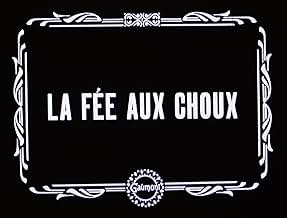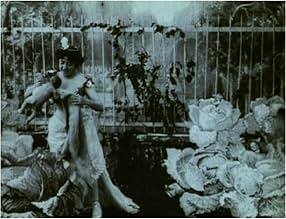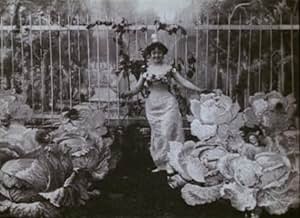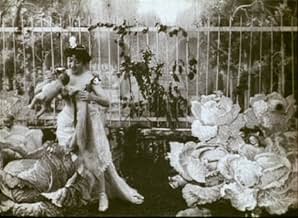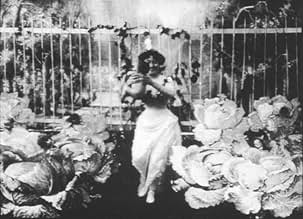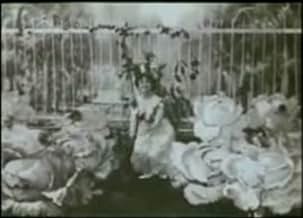NOTE IMDb
5,4/10
1,5 k
MA NOTE
Une étrange fée capable de faire naître et de mettre au monde des bébés issus de choux. Se déplaçant doucement parmi les choux et par de jolis gestes, elle en sort un, puis recourt à la magi... Tout lireUne étrange fée capable de faire naître et de mettre au monde des bébés issus de choux. Se déplaçant doucement parmi les choux et par de jolis gestes, elle en sort un, puis recourt à la magie et en met au monde deux autres.Une étrange fée capable de faire naître et de mettre au monde des bébés issus de choux. Se déplaçant doucement parmi les choux et par de jolis gestes, elle en sort un, puis recourt à la magie et en met au monde deux autres.
- Réalisation
- Scénario
- Casting principal
Avis à la une
You know where babies come from, but do you know the real origins of movies? Contrary to Internet folklore, movies weren't actually born and reproduced of YouTube--not directly or originally, at least. Apparently, that's how many people, including the reviewers on this site, came by this early film, though. Consequently, some lose sense of the picture's meaning and origins. The birds and the bees of the matter, however, is that "The Cabbage-Patch Fairy" was, first, conceived by Alice Guy-Blaché. She related the story of her creation in interviews and her memoir decades after the fact, although her telling of it hasn't quite aligned with the surviving historical record. The earliest cabbage-patch film we have today was rediscovered together on a 35mm reel with other Gaumont productions at the Swedish Film Archive in the late 1990s. Later, it made its way onto DVD, such as in part of the Kino Gaumont set and, from here, ripped and uploaded as video to the web. Along the way, however, these posters ignored the usual dating of the film as c.1900 in favor of trying to substantiate Guy-Blaché's later claims--or, more likely, they chose 1896 as a more sensational date. Thus, it may be proclaimed the first film made by a woman, or, even more preposterously, as the first story film, or some such primacy nonsense. Yet, the truth is it likely isn't Guy's first film (even if it is hers), although it may be a remake of a hypothetical first cabbage-patch film she made in 1896, and neither of those films would be the first story film, anyways--even if this one weren't in the cinema-of-attractions mode as opposed to more of a proto-narrative.
On the other hand, leading historian of Guy, Alison McMahan (in her book, "Alice Guy Blaché: Lost Visionary of the Cinema") makes the best case for this possibly being the 1896 film, as, perhaps, reproduced from an original 58mm print (the size for the camera by Georges Demenÿ that Gaumont first employed). Theoretically, then, as McMahan argues, the cabbage patch set-up based in folklore (like the one involving storks) may be viewed as a demonstration film, with the cabbages standing in for Gaumont's advertising of their cameras and with the babies as the films they make. But even McMahan hedges her bets by suggesting it may be a remake, too. The documentary "Be Natural: The Untold Story of Alice Guy-Blaché" goes so far as to claim it a remake of the now-lost hypothetical 1896 production--although no evidence is offered for this assertion. Others, such as Jane M. Gaines (author of "Pink-Slipped: What Happened to Women in the Silent Film Industry") and Joan Simon ("Alice Guy Blaché: Cinema Pioneer"), meanwhile, have led the way in otherwise forming a consensus around a date c.1900, which film preservationists and such home-video makers as Kino followed for DVD dating. After all, the earliest listing of a cabbage-patch film in surviving Gaumont catalogues, where the film was singled out as "a great success," suggests a 1900 dating. Moreover, the cabbage-patch film that Guy-Blaché described in her later years, besides the 1896 date, more closely resembles a 1902 film of hers, "Midwife to the Upper Class" (1902), which, indeed, is a two-shot narrative film. A photograph of Guy with a couple actors that in the past has erroneously been attributed to and been held up as evidence for an 1896 film, indeed, is from this 1902 production.
Indeed, remakes were common in the cabbage patch of early cinema and not only to rework a familiar narrative, but also as replacement for popular films, such as this one, whose negatives were worn out by the film duplication processes of the era. The prior fiction film, "The Gardener" (1895), for instance, was reborn a few times by the Lumière brothers and other studios. As to establishing Guy's maternity of this earliest surviving cabbage-patch film, it seems likely given that she made two later films involving cabbage-patch babies, the aforementioned 1902 production and a scene from "Madame's Cravings" (1906). Even if not the first film made by her, let alone the first narrative one, "The Cabbage-Patch Fairy" is an interesting piece of early cinema, which I'll discuss in my review under the entry for La fée aux choux, ou la naissance des enfants (1900), the 1900 version of this same, one and only, film we've seen, whether dated 1896 or to 1900.
On the other hand, leading historian of Guy, Alison McMahan (in her book, "Alice Guy Blaché: Lost Visionary of the Cinema") makes the best case for this possibly being the 1896 film, as, perhaps, reproduced from an original 58mm print (the size for the camera by Georges Demenÿ that Gaumont first employed). Theoretically, then, as McMahan argues, the cabbage patch set-up based in folklore (like the one involving storks) may be viewed as a demonstration film, with the cabbages standing in for Gaumont's advertising of their cameras and with the babies as the films they make. But even McMahan hedges her bets by suggesting it may be a remake, too. The documentary "Be Natural: The Untold Story of Alice Guy-Blaché" goes so far as to claim it a remake of the now-lost hypothetical 1896 production--although no evidence is offered for this assertion. Others, such as Jane M. Gaines (author of "Pink-Slipped: What Happened to Women in the Silent Film Industry") and Joan Simon ("Alice Guy Blaché: Cinema Pioneer"), meanwhile, have led the way in otherwise forming a consensus around a date c.1900, which film preservationists and such home-video makers as Kino followed for DVD dating. After all, the earliest listing of a cabbage-patch film in surviving Gaumont catalogues, where the film was singled out as "a great success," suggests a 1900 dating. Moreover, the cabbage-patch film that Guy-Blaché described in her later years, besides the 1896 date, more closely resembles a 1902 film of hers, "Midwife to the Upper Class" (1902), which, indeed, is a two-shot narrative film. A photograph of Guy with a couple actors that in the past has erroneously been attributed to and been held up as evidence for an 1896 film, indeed, is from this 1902 production.
Indeed, remakes were common in the cabbage patch of early cinema and not only to rework a familiar narrative, but also as replacement for popular films, such as this one, whose negatives were worn out by the film duplication processes of the era. The prior fiction film, "The Gardener" (1895), for instance, was reborn a few times by the Lumière brothers and other studios. As to establishing Guy's maternity of this earliest surviving cabbage-patch film, it seems likely given that she made two later films involving cabbage-patch babies, the aforementioned 1902 production and a scene from "Madame's Cravings" (1906). Even if not the first film made by her, let alone the first narrative one, "The Cabbage-Patch Fairy" is an interesting piece of early cinema, which I'll discuss in my review under the entry for La fée aux choux, ou la naissance des enfants (1900), the 1900 version of this same, one and only, film we've seen, whether dated 1896 or to 1900.
Let's talk about Alice Guy. She started out as a secretary at Gaumont and was soon put in charge of film production, yet for some reason, although her IMDb page credits her first movie as director as LES DEMOLISSEURS, (now apparently lost), the page for this movie appears later in production, has a release date of 1900 and the IMDb claims it is the first movie directed by a woman. It's also written by her. It also credits her as one of three actresses appearing in the movie, although there is only one.
It's a minute and a half of a woman in fancy dress dancing around a cabbage field, occasionally plucking a baby out. Some modern feminist writers claim that early women in the film business were a lot like modern feminists. I think it better to actually look at the works of early movies, as many of them as possible, and then make up your mind. This looks silly and charming and not the least feminist to me. Clearly someone -- or several people -- have been talking about Mlle. Guy and this movie without bothering to look at anything pertinent.
It's a minute and a half of a woman in fancy dress dancing around a cabbage field, occasionally plucking a baby out. Some modern feminist writers claim that early women in the film business were a lot like modern feminists. I think it better to actually look at the works of early movies, as many of them as possible, and then make up your mind. This looks silly and charming and not the least feminist to me. Clearly someone -- or several people -- have been talking about Mlle. Guy and this movie without bothering to look at anything pertinent.
Considered the first film made by a female director and the first feature of fiction in cinema, "The Cabbage Fairy" (La fée aux choux) is a charming piece of film history. Based on a European fairy tale, the film is a minute-sized glimpse at the directress Alice Guy-Blaché playing a fairy who plucks babies out of cabbages while employing theatrical gestures with a winning smile in every move. Pioneering and still quite entertaining, the film is a fascinating view on the origins of film and the distant past.
This strange but cute little film was apparently the first one ever directed by a woman. Alice Guy (later Alice Guy Blaché) made what is in some ways very indicative of the 1890s--a film only about a minute long and with an underdeveloped plot. However, the set is actually very nice for the time as is the woman's costume. Compared to the Lumiere Brothers' films of the day, this one is much more interesting and isn't about mundane everyday activities (such as folks leaving work or babies eating). It consists of a woman(Guy herself) who you assume is some sort of fairy. She's in the cabbage patch pulling out babies from the plants. It's certainly NOT the best sexual health and reproduction lesson I've seen and is kind of goofy...but cute at the same time.
One reviewer went on and on about how abusive the film was towards these poor naked babies...I just thought it was kind of cute and nothing more. But, I must admit that the fairy was awfully rough with the babies! This is an interesting review to read.
By the way, I am not giving this one a numerical score and I often don't with the earliest films because they are so short and simple that they defy scoring.
One reviewer went on and on about how abusive the film was towards these poor naked babies...I just thought it was kind of cute and nothing more. But, I must admit that the fairy was awfully rough with the babies! This is an interesting review to read.
By the way, I am not giving this one a numerical score and I often don't with the earliest films because they are so short and simple that they defy scoring.
Ms. Guy, an enchanting actor, makes the connection between humanity and nature. Mirthful and succinct. -David Olive, Toronto
Le saviez-vous
- AnecdotesConsidered to be the first ever fiction film by historians.
- ConnexionsFeatured in Be Natural : L'Histoire cachée d'Alice Guy-Blaché (2018)
Meilleurs choix
Connectez-vous pour évaluer et suivre la liste de favoris afin de recevoir des recommandations personnalisées
Détails
- Durée
- 1min
- Couleur
- Mixage
Contribuer à cette page
Suggérer une modification ou ajouter du contenu manquant


